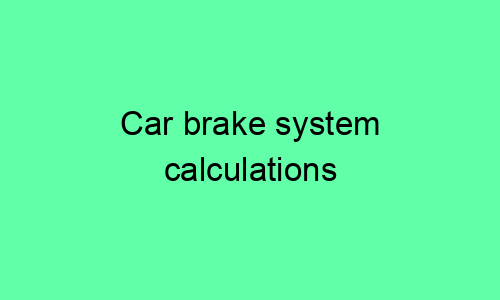Car Brake System Calculations
Introduction
The brake system is one of the most important safety features on a car. It allows the driver to slow down or stop the car by applying friction to the wheels. The brake system consists of several components, including the brake pedal, brake master cylinder, brake lines, brake calipers, and brake pads.
When the brake pedal is depressed, the brake master cylinder sends brake fluid through the brake lines to the brake calipers. The brake calipers then apply pressure to the brake pads, which rub against the brake rotors to create friction and slow down the car.
The effectiveness of the brake system depends on a number of factors, including the coefficient of friction between the brake pads and the brake rotors, the surface area of the brake pads, and the hydraulic pressure applied to the brake calipers.
Coefficient of Friction
The coefficient of friction is a measure of the amount of friction between two surfaces. The coefficient of friction between brake pads and brake rotors typically ranges from 0.3 to 0.5. A higher coefficient of friction means that more friction is created for a given amount of pressure, which results in better braking performance.
Surface Area
The surface area of the brake pads is also an important factor in determining the effectiveness of the brake system. A larger surface area means that more friction can be created for a given amount of pressure. This is why race cars often have larger brake pads than street cars.
Hydraulic Pressure
The hydraulic pressure applied to the brake calipers is the final factor that determines the effectiveness of the brake system. The higher the hydraulic pressure, the more force is applied to the brake pads, which results in better braking performance.
Brake System Calculations
The following equations can be used to calculate the braking force, braking torque, and stopping distance of a car.
Braking Force
The braking force is the force that is applied to the wheels to slow down or stop the car. The braking force is equal to the coefficient of friction times the normal force between the brake pads and the brake rotors.
F_b = μ * F_n
where:
* F_b is the braking force
* μ is the coefficient of friction
* F_n is the normal force
Braking Torque
The braking torque is the torque that is applied to the wheels to slow down or stop the car. The braking torque is equal to the braking force times the radius of the brake rotors.
T_b = F_b * r
where:
* T_b is the braking torque
* F_b is the braking force
* r is the radius of the brake rotors
Stopping Distance
The stopping distance is the distance that the car travels from the time the brakes are applied until the car comes to a stop. The stopping distance is equal to the square of the velocity divided by twice the deceleration.
d = v^2 / (2 * a)
where:
* d is the stopping distance
* v is the velocity
* a is the deceleration
Conclusion
The brake system is a critical safety feature on a car. The effectiveness of the brake system depends on a number of factors, including the coefficient of friction, surface area, and hydraulic pressure. The equations provided in this article can be used to calculate the braking force, braking torque, and stopping distance of a car.






